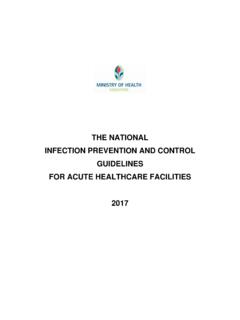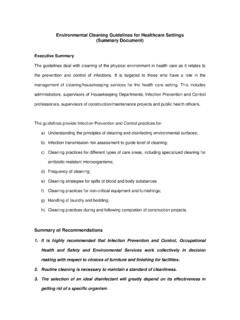Transcription of Contents page - Ministry of Health
1 Foreword by Director of Medical i Foreword by Chief Pharmacist .. iiAcknowledgements .. iii Executive summary .. 1 Section 1 Introduction: Medication safety 3 Definitions 3 Facts about medication errors 3 Steps to reduce errors 4 Section 2 The Medication use process: Prescribing, dispensing and administration 8 Safer prescribing of medicines 14 Safer dispensing of medicines 15 Safer administration of medicines 17 Section 3 Improving medication use process 20 Medication safety audit for physicians 22 Medication safety audit for pharmacists 22 Medication safety audit for nurses 22 Computerised prescriber order entry system 22 Improving labelling and
2 Packaging 27 Patient s role in medication safety 28 Section 4 Reducing risks in a specific population 29 Reducing risks in people with allergies 29 Reducing risks in paediatrics 29 Reducing risks in geriatrics 30 References .. 31 Appendix 1 Medication safety audit list for physicians 32 Appendix 2 Medication safety audit list for pharmacists 40 Appendix 3 Medication safety audit list for nurses 53 Appendix 4 ISMP s list of error-prone abbreviations.
3 Symbols and dose designations 64 Appendix 5 ISMP s list of high alert medication 65 Appendix 6 Medications with similar looking/sounding names 66 Appendix 7 Practice standards for pre-packing of drugs for healthcare institutions and pharmacies in Singapore 70 Appendix 8 Drug safety notification form 74 Appendix 9 Medication safety tips for patients 75 Appendix 10 Patient information leaflet How to take your medication safely 76 Appendix 11 Useful information 83 Contents pageForeword by Director of Medical ServicesIMedication safety has long been recognized to be important in the provision of patient care.
4 With the evidence now pointing to medication errors as one of the leading causes of avoidable complications and deaths, there is a pressing need for a better understanding of the nature and scope of medication errors, and the will to improve the current clinical delivery systems. In Singapore, the prescribing and dispensing standards are high and the vast majority of drug treatment is provided safely. We must, however, remain committed to ensuring that medication use is made as safe as possible, since a prescribed medication is the most frequent treatment provided to patients.
5 For this reason, I am very pleased that the pharmacy profession has taken the lead in developing this practice guide. I hope that the tools in this guide will lead to the identification of gaps in our system and spur improvements in medication use locally. Pharmacists and all members of the healthcare team will have to work together to transform the information in these pages into practice and ensure that the medication use process is safe from beginning to end. This will be critical in the face of an increasingly complex healthcare would like to thank all who have helped produce this guide.
6 Special thanks are due to Chief Pharmacist, Ms Ang Hui Gek, and the members of her K SatkuDirector of Medical ServicesMinistry of HealthFebruary 2006 Foreword by Chief PharmacistIIThe landmark report To err is human by the Institute of Medicine established that medication errors are the leading causes of death and occurs in all Health care systems. Minimising medication errors in the total medication use process is therefore of strategic importance in improving patient safety in the healthcare Medication Safety Practices Guide is written to serve as a reference tool, and to encourage Health care professionals to take a proactive approach to ensuring medication safety, rather than waiting for an error or patient harm to occur.
7 The guidelines and best practices collected in this guide are applicable to all Health care professionals, not limited but especially for doctors, pharmacists, nurses and patient support staff. The guidelines are categorized according to stages of the medication use process. However, it is important to note that no single Health care professional s role is neatly confined to any one section or stage as the total medication use process is a continuum; the inputs and outputs at each stage affect the the increasing use of information technology and systems, such as electronic patient records and electronic prescribing, new issues have resulted.
8 This guide has also dedicated a chapter on the key features of a well-designed information management system to reduce the mistakes and lapses in medication order and use. Even as new technologies and new drugs potentially provide a more efficient system and effective remedies, systems and human errors will continue to harm. The key approach is really to take a proactive step to creating a patient safety mindset, environment and culture amongst Health care providers, by developing good practices and encouraging right attitudes and habits in the workplace.
9 I hope that you will find this guide useful and valuable to your practice. Let s build a SAFE system and breathe SAFETY for the good of all, patients and healthcare Hui Gek (Ms)Chief PharmacistMinistry of HealthFebruary 2006 Workgroup membersChairperson Ms Lita Chew Pharmacy Manager, National Cancer Centre Adjunct Assistant Professor, National University of Singapore Secretary Ms Jade Yong Pharmacist / Pharmacy Executive, Ministry of Health Members Ms Goh Lay Hong Senior Pharmacist, Tan Tock Seng Hospital Ms Lee Soo Boon Principal Pharmacist, Singapore General Hospital Ms Lim Siew Mei Principal Pharmacist, National University Hospital Ms Ng Ai Shing Pharmacist.
10 KK Women & Childrens Hospital Mr Jonathan Seah Pharmacist, Changi General Hospital Mr Soon Boon Tan Assistant Director Pharmacy, SingHealth Polyclinics Ms Tan Lay Kheng Pharmacy Practice Manager National Healthcare Group Polyclinics Ms Elizabeth Tian Senior Pharmacist, National Skin CenterAcknowledgements The committee would like to express its appreciation to Dr Loh Yik Hin (Deputy Director of Integrated Health Services), Ms Ang Beng Choo (Chief Nursing Officer) and Ms Chen Yee Chui (Professional Standards Executive Nursing Service) of the Ministry of Health , for their invaluable comments and for reviewing the Guide.











